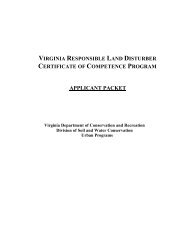Dameron Marsh NAP self-guided field trip guide - Virginia ...
Dameron Marsh NAP self-guided field trip guide - Virginia ...
Dameron Marsh NAP self-guided field trip guide - Virginia ...
You also want an ePaper? Increase the reach of your titles
YUMPU automatically turns print PDFs into web optimized ePapers that Google loves.
Stop 5...<br />
• To the right in the lower lying swale is salt meadow hay (Spartina patens). Salt meadow hay has a tidy mowed<br />
look and is usually dry enough to walk on. Historically cattle grazed on the salt meadow hay marshes and the<br />
grass was often mowed for fodder.<br />
• In 2001 Natural Heritage staff initiatied a Wetland Restoration project on the preserve, here you can see faint evidence<br />
of one of the many ditch plugs installed in 2001. These low earthen berms were installed to stop drainage<br />
of the <strong>field</strong>s.<br />
• Paid for by money from the US Army Corps of Engineers Wetland Restoration Trust Fund—this was a cooperative<br />
project involving DCR’s Land Steward, The Nature Conservancy’s Wetland Scientist and staff from the<br />
Army Corps of Engineers.<br />
• 40 acres of old <strong>field</strong>s are in the process of being restored to forested wetlands. To the south of the trail , the low<br />
grass that you see is Salt Meadow Hay which has spread into this area since the water level has risen.<br />
• You can see Phragmites australis in the distance. This grass threatens the mash with all out invasion. It could<br />
easily take over all of the wet areas of <strong>Dameron</strong> <strong>Marsh</strong>. With help again from the Wetland Restoration Trust<br />
fund, we are actively spraying this grass ( both with back pack sprayers and aerially from a helicopter) with a<br />
chemical called Rodeo—which works much like Round-up but is approved for use in wetlands.<br />
• Look for Saltmarsh fleabane in bloom ). It has tiny pink flowers concentrated into flowerheads resembling milkweed<br />
and it blooms from mid-summer through fall. (Crush the leaves and you’ll get a medicinal smell which gave<br />
rise to another of its common names – camphorweed.)<br />
• There is a good example of the invasive exotic plant Sericea Lespedeza—we have been trying to eradicate this<br />
plant.<br />
Saltmarsh fleabane<br />
Pluchea odorata<br />
Salt meadow hay<br />
Spartina patens<br />
Sericea lespedeza<br />
Lespedeza cuneata
















